Interpretable Clinical Decision Support System for Audiology Based on Predicted Common Audiological Functional Parameters (CAFPAs)
Abstract
:1. Introduction
- Model-predicted and expert-estimated CAFPAs were investigated to determine whether they could provide equivalent classification performance;
- The classification approach and evaluation was extended to applicability for individual patients, and;
- The interpretability of the obtained CDSS was investigated.
2. Materials and Methods
2.1. Common Audiological Functional Parameters (CAFPAs)
2.2. Data Set
2.3. Prediction of CAFPAs
2.4. Classification
2.4.1. Expert-Estimated vs. Model-Predicted CAFPAs (Comparison Sets)
2.4.2. Individual Patients (Tree Sets)
3. Results
3.1. Expert-Estimated vs. Model-Predicted CAFPAs (Comparison Sets)
3.2. Individual Patients (Tree Sets)
4. Discussion
4.1. Classification Based on Expert-Estimated vs. Model-Predicted CAFPAs
4.2. Classification of Individual Patients
4.3. Interplay between Experts and CDSS and Interpretability
4.4. CDSS for Audiology Based on CAFPAs
4.5. Towards Integration of Clinical Databases
5. Conclusions
Supplementary Materials
Funding
Data Availability Statement
Acknowledgments
Conflicts of Interest
Abbreviations
| ACALOS | Adaptive categorical loudness scaling |
| Accuracy | |
| BTE | Behind-the-ear hearing aid |
| c | Classified category (index) |
| CAFPAs | Common Audiological Functional Parameters |
| - | Hearing threshold-related CAFPAs |
| - | Supra-threshold CAFPAs |
| Binaural CAFPA | |
| Neural CAFPA | |
| Cognitive CAFPA | |
| Socio-economic CAFPA | |
| CDSS | Clinical decision support system |
| Certainty | |
| CI | Cochlear implant |
| cond | Conductive hearing loss |
| CS | Comparison set |
| Device | Any hearing device |
| GÖSA | Goettingen sentence test |
| HA | Hearing aid |
| HI | Hearing impaired |
| high | High-frequency hearing loss |
| HiGHmed | Heidelberg–Göttingen–Hannover Medical Informatics |
| ITE | In-the-ear hearing aid |
| N | Number of patients |
| NH | Normal hearing |
| None | No hearing device |
| openEHR | Open electronic health record |
| p | Probability |
| CAFPA value [0 1] | |
| recr | Recruitment |
| rel-all | Weights common for all models |
| rel-model | Weights derived for different prediction models |
| Sensitivity | |
| Specificity | |
| SWI | Scheuch–Winkler index |
| uniform | Uniform weights |
| Y | Youden index |
| Youden index criterion, values higher than 90 % of |
Appendix A
Appendix A.1. Confusion Matrices for All Weights
| Tree Set I | Tree Set II | Tree Set III | |||||||||
|---|---|---|---|---|---|---|---|---|---|---|---|
| Weights | Model | Category | Category (Expert) | ||||||||
| (Predicted) | 1 | 2 | 3 | 1 | 2 | 3 | 1 | 2 | 3 | ||
| uniform | Lasso regression | 3 | 1 | 20 | 37 | 16 | 61 | 98 | 0 | 7 | 17 |
| 2 | 31 | 99 | 21 | 16 | 14 | 4 | 29 | 79 | 23 | ||
| 1 | 26 | 5 | 0 | 26 | 4 | 1 | 71 | 14 | 0 | ||
| Elastic net | 3 | 2 | 20 | 37 | 17 | 62 | 98 | 0 | 7 | 17 | |
| 2 | 30 | 99 | 21 | 15 | 13 | 4 | 29 | 77 | 23 | ||
| 1 | 26 | 5 | 0 | 26 | 4 | 1 | 71 | 16 | 0 | ||
| Random forest | 3 | 1 | 30 | 37 | 17 | 64 | 100 | 0 | 9 | 22 | |
| 2 | 21 | 86 | 21 | 5 | 8 | 2 | 28 | 77 | 18 | ||
| 1 | 36 | 8 | 0 | 36 | 7 | 1 | 72 | 14 | 0 | ||
| rel-model | Lasso regression | 3 | 2 | 8 | 24 | 13 | 55 | 100 | 0 | 4 | 17 |
| 2 | 26 | 102 | 44 | 15 | 14 | 9 | 21 | 100 | 22 | ||
| 1 | 28 | 6 | 0 | 28 | 5 | 1 | 62 | 14 | 0 | ||
| Elastic net | 3 | 1 | 5 | 21 | 11 | 53 | 102 | 0 | 4 | 18 | |
| 2 | 27 | 105 | 47 | 17 | 16 | 7 | 20 | 99 | 21 | ||
| 1 | 28 | 6 | 0 | 28 | 5 | 1 | 63 | 15 | 0 | ||
| Random forest | 3 | 2 | 23 | 39 | 15 | 53 | 100 | 0 | 6 | 25 | |
| 2 | 19 | 86 | 29 | 6 | 14 | 10 | 18 | 96 | 14 | ||
| 1 | 35 | 7 | 0 | 35 | 7 | 0 | 65 | 16 | 0 | ||
| rel-all | Lasso regression | 3 | 2 | 17 | 37 | 19 | 60 | 96 | 0 | 4 | 18 |
| 2 | 24 | 112 | 13 | 7 | 17 | 6 | 20 | 101 | 19 | ||
| 1 | 29 | 6 | 0 | 29 | 2 | 4 | 68 | 10 | 0 | ||
| Elastic net | 3 | 2 | 17 | 35 | 21 | 62 | 97 | 0 | 5 | 18 | |
| 2 | 26 | 112 | 15 | 7 | 15 | 5 | 20 | 100 | 19 | ||
| 1 | 27 | 6 | 0 | 27 | 2 | 4 | 68 | 10 | 0 | ||
| Random forest | 3 | 2 | 26 | 36 | 15 | 61 | 92 | 0 | 8 | 23 | |
| 2 | 19 | 101 | 14 | 6 | 14 | 10 | 18 | 95 | 14 | ||
| 1 | 34 | 8 | 0 | 34 | 4 | 4 | 70 | 12 | 0 | ||
Appendix A.2. Certainty for All Tree Sets and Weights
| Classified Category | |||||
|---|---|---|---|---|---|
| Tree Set | Weights | Model | 1 | 2 | 3 |
| Median [Interquartile Range] | |||||
| I | uniform | Expert | 0.66 [0.57 0.71] | 0.33 [0.30 0.36] | 0.44 [0.40 0.48] |
| Lasso regression | 0.60 [0.55 0.62] | 0.34 [0.32 0.37] | 0.42 [0.39 0.44] | ||
| Elastic net | 0.59 [0.55 0.62] | 0.34 [0.32 0.37] | 0.42 [0.39 0.45] | ||
| Random forest | 0.64 [0.59 0.66] | 0.34 [0.31 0.36] | 0.42 [0.40 0.47] | ||
| rel-model | Expert | 0.67 [0.56 0.73] | 0.33 [0.31 0.37] | 0.42 [0.38 0.46] | |
| Lasso regression | 0.60 [0.55 0.65] | 0.36 [0.32 0.40] | 0.39 [0.38 0.42] | ||
| Elastic net | 0.60 [0.54 0.64] | 0.36 [0.32 0.39] | 0.41 [0.38 0.43] | ||
| Random forest | 0.67 [0.59 0.69] | 0.43 [0.41 0.46] | 0.53 [0.44 0.63] | ||
| rel-all | Expert | 0.66 [0.57 0.72] | 0.42 [0.38 0.47] | 0.65 [0.48 0.74] | |
| Lasso regression | 0.59 [0.54 0.65] | 0.42 [0.39 0.45] | 0.47 [0.42 0.60] | ||
| Elastic net | 0.60 [0.55 0.65] | 0.42 [0.39 0.45] | 0.47 [0.43 0.62] | ||
| Random forest | 0.65 [0.59 0.68] | 0.43 [0.40 0.47] | 0.52 [0.42 0.62] | ||
| II | uniform | Expert | 0.66 [0.57 0.71] | 0.31 [0.27 0.34] | 0.40 [0.33 0.43] |
| Lasso regression | 0.60 [0.55 0.62] | 0.27 [0.26 0.29] | 0.40 [0.33 0.43] | ||
| Elastic net | 0.59 [0.55 0.62] | 0.27 [0.26 0.29] | 0.40 [0.33 0.43] | ||
| Random forest | 0.64 [0.59 0.66] | 0.27 [0.27 0.30] | 0.41 [0.34 0.44] | ||
| rel-model | Expert | 0.67 [0.56 0.73] | 0.32 [0.30 0.38] | 0.42 [0.34 0.45] | |
| Lasso regression | 0.60 [0.55 0.65] | 0.30 [0.29 0.31] | 0.43 [0.37 0.47] | ||
| Elastic net | 0.60 [0.54 0.64] | 0.32 [0.30 0.32] | 0.45 [0.38 0.50] | ||
| Random forest | 0.67 [0.59 0.69] | 0.29 [0.29 0.31] | 0.43 [0.36 0.46] | ||
| rel-all | Expert | 0.66 [0.57 0.72] | 0.35 [0.32 0.43] | 0.40 [0.34 0.46] | |
| Lasso regression | 0.59 [0.54 0.65] | 0.29 [0.28 0.42] | 0.41 [0.35 0.45] | ||
| Elastic net | 0.60 [0.55 0.65] | 0.29 [0.28 0.40] | 0.41 [0.35 0.45] | ||
| Random forest | 0.65 [0.59 0.68] | 0.29 [0.28 0.31] | 0.42 [0.36 0.45] | ||
| III | uniform | Expert | 0.59 [0.54 0.69] | 0.36 [0.34 0.37] | 0.46 [0.41 0.52] |
| Lasso regression | 0.58 [0.54 0.64] | 0.37 [0.36 0.38] | 0.43 [0.40 0.48] | ||
| Elastic net | 0.57 [0.53 0.64] | 0.37 [0.36 0.38] | 0.43 [0.41 0.47] | ||
| Random forest | 0.60 [0.53 0.67] | 0.37 [0.36 0.38] | 0.45 [0.39 0.46] | ||
| rel-model | Expert | 0.66 [0.55 0.74] | 0.39 [0.36 0.42] | 0.47 [0.40 0.53] | |
| Lasso regression | 0.60 [0.55 0.68] | 0.39 [0.37 0.41] | 0.46 [0.41 0.49] | ||
| Elastic net | 0.60 [0.54 0.68] | 0.39 [0.37 0.41] | 0.46 [0.42 0.50] | ||
| Random forest | 0.65 [0.53 0.72] | 0.39 [0.38 0.41] | 0.47 [0.42 0.50] | ||
| rel-all | Expert | 0.63 [0.54 0.72] | 0.38 [0.36 0.39] | 0.49 [0.43 0.53] | |
| Lasso regression | 0.60 [0.55 0.67] | 0.38 [0.37 0.40] | 0.46 [0.42 0.50] | ||
| Elastic net | 0.60 [0.54 0.68] | 0.38 [0.37 0.40] | 0.47 [0.42 0.50] | ||
| Random forest | 0.64 [0.53 0.71] | 0.39 [0.37 0.40] | 0.47 [0.42 0.50] | ||
References
- Belle, V.; Papantonis, I. Principles and Practice of Explainable Machine Learning. Front. Big Data 2021, 4, 688969. [Google Scholar] [CrossRef] [PubMed]
- Shortliffe, E.H.; Cimino, J.J. Biomedical Informatics: Computer Applications in Health Care and Biomedicine; Springer: London, UK, 2014. [Google Scholar]
- Shibl, R.; Lawley, M.; Debuse, J. Factors influencing decision support system acceptance. Decis. Support Syst. 2013, 54, 953–961. [Google Scholar] [CrossRef]
- Bietenbeck, A.; Streichert, T. Preparing Laboratories for Interconnected Health Care. Diagnostics 2021, 11, 1487. [Google Scholar] [CrossRef]
- Spreckelsen, C.; Spitzer, K. Wissensbasen und Expertensysteme in der Medizin: KI-Ansätze zwischen klinischer Entscheidungsunterstützung und medizinischem Wissensmanagement; Vieweg + Teubner|GWV Fachverlage GmbH: Wiesbaden, Germany, 2008. [Google Scholar]
- Sandryhaila, A.; Moura, J.M. Big data analysis with signal processing on graphs: Representation and processing of massive data sets with irregular structure. IEEE Signal Process. Mag. 2014, 31, 80–90. [Google Scholar] [CrossRef]
- Medlock, S.; Wyatt, J.C.; Patel, V.L.; Shortliffe, E.H.; Abu-Hanna, A. Modeling information flows in clinical decision support: Key insights for enhancing system effectiveness. J. Am. Med. Inform. Assoc. 2016, 23, 1001–1006. [Google Scholar] [CrossRef] [Green Version]
- Carvalho, D.V.; Pereira, E.M.; Cardoso, J.S. Machine Learning Interpretability: A Survey on Methods and Metrics. Electronics 2019, 8, 832. [Google Scholar] [CrossRef] [Green Version]
- Galvin, K.L.; Featherston, R.J.; Downie, L.E.; Vogel, A.P.; Hamilton, B.; Granger, C.; Shlonsky, A. A Systematic Review of Interventions to Reduce the Effects of Cognitive Biases in the Decision-Making of Audiologists. J. Am. Acad. Audiol. 2020, 31, 158–167. [Google Scholar] [CrossRef]
- Rüping, S. Big Data in Medizin und Gesundheitswesen. Bundesgesundheitsblatt Gesundheitsforschung Gesundheitsschutz 2015, 58, 794–798. [Google Scholar] [CrossRef]
- Walter, Z.; Lopez, S.M. Physician acceptance of information technologies: Role of perceived threat to professional autonomy. Decis. Support Syst. 2008, 46, 206–215. [Google Scholar] [CrossRef]
- Khairat, S.; Marc, D.; Crosby, W.; Al Sanousi, A. Reasons For Physicians Not Adopting Clinical Decision Support Systems: Critical Analysis. JMIR Med. Inform. 2018, 6, e24. [Google Scholar] [CrossRef]
- HiGHmed. HiGHmed Medical Informatics. Available online: https://www.highmed.org/ (accessed on 12 November 2021).
- Beale, T. Archetypes: Constraint-based domain models for future-proof information systems. In Proceedings of the OOPSLA 2002 Workshop on Behavioural Semantics, Seattle, WA, USA, 4–8 November 2002; Volume 105, pp. 1–69. [Google Scholar]
- Wulff, A.; Baier, C.; Ballout, S.; Tute, E.; Sommer, K.K.; Kaase, M.; Sargeant, A.; Drenkhahn, C.; Schlüter, D.; Marschollek, M.; et al. Transformation of microbiology data into a standardised data representation using OpenEHR. Sci. Rep. 2021, 11, 10556. [Google Scholar] [CrossRef]
- Lenarz, T.; Boenninghaus, H.G. Hals-Nasen-Ohren-Heilkunde; Springer: Berlin/Heidelberg, Germany, 2012. [Google Scholar]
- Lehnhardt, E.; Laszig, R. Praxis der Audiometrie; Georg Thieme Verlag: Stuttgart, Germany, 2009. [Google Scholar]
- Deutsche Gesellschaft für Hals-Nasen-Ohren-Heilkunde, Kopf- und Hals-Chirurgie e. V. (DGHNO-KHC). S2k-Leitlinie Cochlea-Implantat Versorgung. AWMF-Register-Nr. 017/071. 2020. Available online: https://www.awmf.org/uploads/tx_szleitlinien/017-071l_S2k_Cochlea-Implantat-Versorgung-zentral-auditorische-Implantate_2020-12.pdf (accessed on 15 November 2021).
- Hahlbrock, K.H. Über Sprachaudiometrie und neue Wörterteste. Eur. Arch. Oto-Rhino-Laryngol. 1953, 162, 394–431. [Google Scholar] [CrossRef]
- Wagener, K.; Kühnel, V.; Kollmeier, B. Development and evaluation of a German sentence test I: Design of the Oldenburg sentence test. Z. Audiol. 1999, 38, 4–15. [Google Scholar]
- Wagener, K.; Brand, T.; Kollmeier, B. Development and evaluation of a German sentence test Part II: Optimization of the Oldenburg sentence test. Z. Audiol. 1999, 38, 44–56. [Google Scholar]
- Wagener, K.; Brand, T.; Kollmeier, B. Development and evaluation of a German sentence test part III: Evaluation of the Oldenburg sentence test. Z. Audiol. 1999, 38, 86–95. [Google Scholar]
- Kollmeier, B.; Warzybok, A.; Hochmuth, S.; Zokoll, M.A.; Uslar, V.; Brand, T.; Wagener, K.C. The multilingual matrix test: Principles, applications, and comparison across languages: A review. Int. J. Audiol. 2015, 54 (Suppl. 2), 3–16. [Google Scholar] [CrossRef]
- Kollmeier, B.; Wesselkamp, M. Development and evaluation of a German sentence test for objective and subjective speech intelligibility assessment. J. Acoust. Soc. Am. 1997, 102, 2412–2421. [Google Scholar] [CrossRef]
- Sanchez-Lopez, R.; Bianchi, F.; Fereczkowski, M.; Santurette, S.; Dau, T. Data-Driven Approach for Auditory Profiling and Characterization of Individual Hearing Loss. Trends Hear. 2018, 22, 233121651880740. [Google Scholar] [CrossRef]
- Sanchez-Lopez, R.; Fereczkowski, M.; Neher, T.; Santurette, S.; Dau, T. Robust Data-Driven Auditory Profiling Towards Precision Audiology. Trends Hear. 2020, 24, 233121652097353. [Google Scholar] [CrossRef]
- Tarnowska, K.A.; Dispoto, B.C.; Conragan, J. Explainable AI-based clinical decision support system for hearing disorders. In Proceedings of the AMIA Annual Symposium, San Diego, CA, USA, 30 October–3 November 2021; Volume 2021, p. 595. [Google Scholar]
- Liao, W.-H.; Cheng, Y.-F.; Chen, Y.-C.; Lai, Y.-H.; Lai, F.; Chu, Y.-C. Physician decision support system for idiopathic sudden sensorineural hearing loss patients. J. Chin. Med. Assoc. 2021, 84, 101–107. [Google Scholar] [CrossRef]
- Naveed Anwar, M.; Philip Oakes, M. Decision Support System for the Selection of an ITE or a BTE Hearing Aid. Int. J. Comput. Appl. 2013, 76, 37–42. [Google Scholar] [CrossRef]
- Buhl, M.; Warzybok, A.; Schädler, M.R.; Lenarz, T.; Majdani, O.; Kollmeier, B. Common Audiological Functional Parameters (CAFPAs): Statistical and compact representation of rehabilitative audiological classification based on expert knowledge. Int. J. Audiol. 2019, 5, 231–245. [Google Scholar] [CrossRef] [PubMed]
- Buhl, M.; Warzybok, A.; Schädler, M.R.; Majdani, O.; Kollmeier, B. Common Audiological Functional Parameters (CAFPAs) for single patient cases: Deriving statistical models from an expert-labelled data set. Int. J. Audiol. 2020, 59, 534–547. [Google Scholar] [CrossRef] [PubMed]
- Buhl, M.; Warzybok, A.; Schädler, M.R.; Kollmeier, B. Sensitivity and specificity of automatic audiological classification using expert-labelled audiological data and Common Audiological Functional Parameters (CAFPAs). Int. J. Audiol. 2021, 60, 16–26. [Google Scholar] [CrossRef]
- Saak, S.K.; Hildebrandt, A.; Kollmeier, B.; Buhl, M. Predicting Common Audiological Functional Parameters (CAFPAs) as Interpretable Intermediate Representation in a Clinical Decision-Support System for Audiology. Front. Digit. Health 2020, 2, 596433. [Google Scholar] [CrossRef]
- Gieseler, A.; Tahden, M.A.; Thiel, C.M.; Wagener, K.C.; Meis, M.; Colonius, H. Auditory and Non-Auditory Contributions for Unaided Speech Recognition in Noise as a Function of Hearing Aid Use. Front. Psychol. 2017, 8, 219. [Google Scholar] [CrossRef] [Green Version]
- Oetting, D.; Brand, T.; Ewert, S.D. Optimized loudness-function estimation for categorical loudness scaling data. Hear. Res. 2014, 316, 16–27. [Google Scholar] [CrossRef] [PubMed]
- Kalbe, E.; Kessler, J.; Calabrese, P.; Smith, R.; Passmore, A.P.; Brand, M.A.; Bullock, R. DemTect: A new, sensitive cognitive screening test to support the diagnosis of mild cognitive impairment and early dementia. Int. J. Geriatr. Psychiatry 2004, 19, 136–143. [Google Scholar] [CrossRef]
- Schmidt, K.-H.; Metzler, P. Wortschatztest; Beltz: Göttingen, Germany, 1992. [Google Scholar]
- Winkler, J.; Stolzenberg, H. Adjustierung des Sozialen-Schicht-Index für die Anwendung im Kinder-und Jugendgesundheitssurvey (KiGGS) (No. 07/2009); Wismarer Diskussionspapiere: Wismar, Germany, 2009. [Google Scholar]
- Hastie, T.; Tibshirani, R.; Friedman, J. The Elements of Statistical Learning: Data Mining, Inference, and Prediction; Springer Science & Business Media: New York, NY, USA, 2009. [Google Scholar]
- James, G.; Witten, D.; Hastie, T.; Tibshirani, R. An Introduction to Statistical Learning (Bd. 103); Springer: New York, NY, USA, 2013. [Google Scholar] [CrossRef]
- Wei, Q.; Dunbrack, R.L. The Role of Balanced Training and Testing Data Sets for Binary Classifiers in Bioinformatics. PLoS ONE 2013, 8, e67863. [Google Scholar] [CrossRef] [Green Version]
- Mousavi, H.; Buhl, M.; Guiraud, E.; Drefs, J.; Lücke, J. Inference and Learning in a Latent Variable Model for Beta Distributed Interval Data. Entropy 2021, 23, 552. [Google Scholar] [CrossRef]
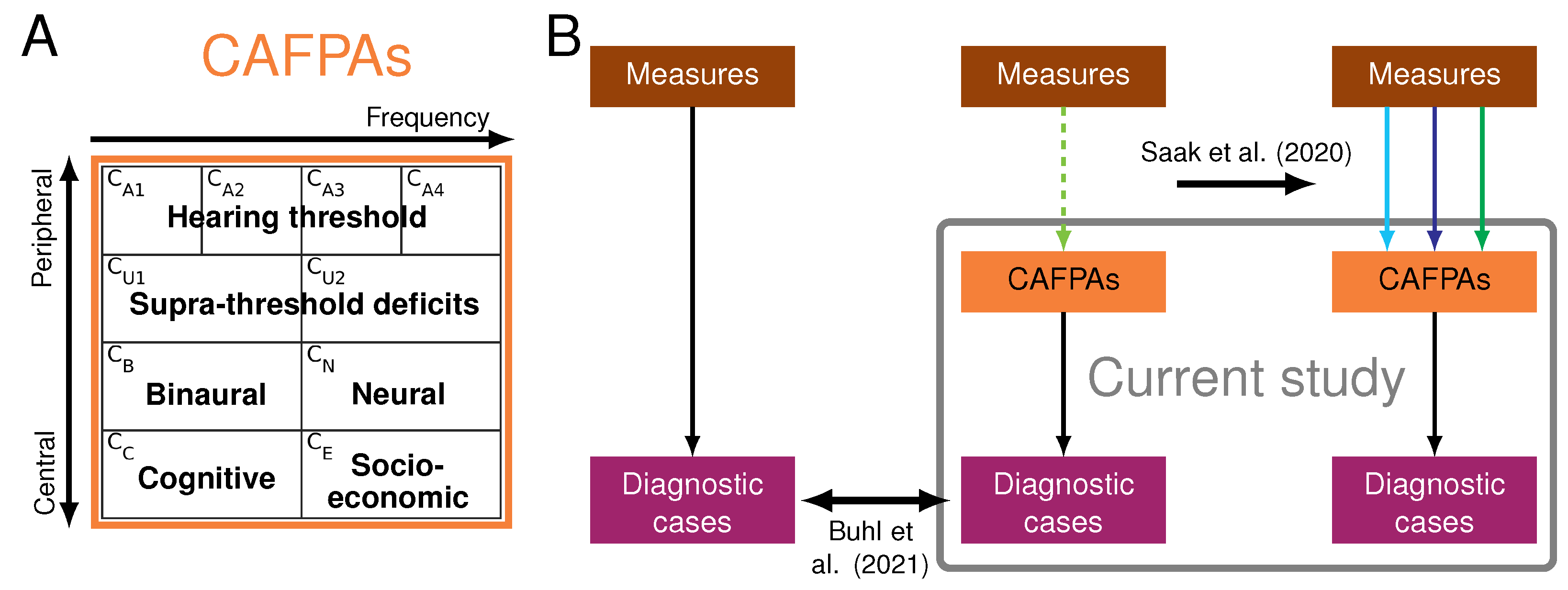
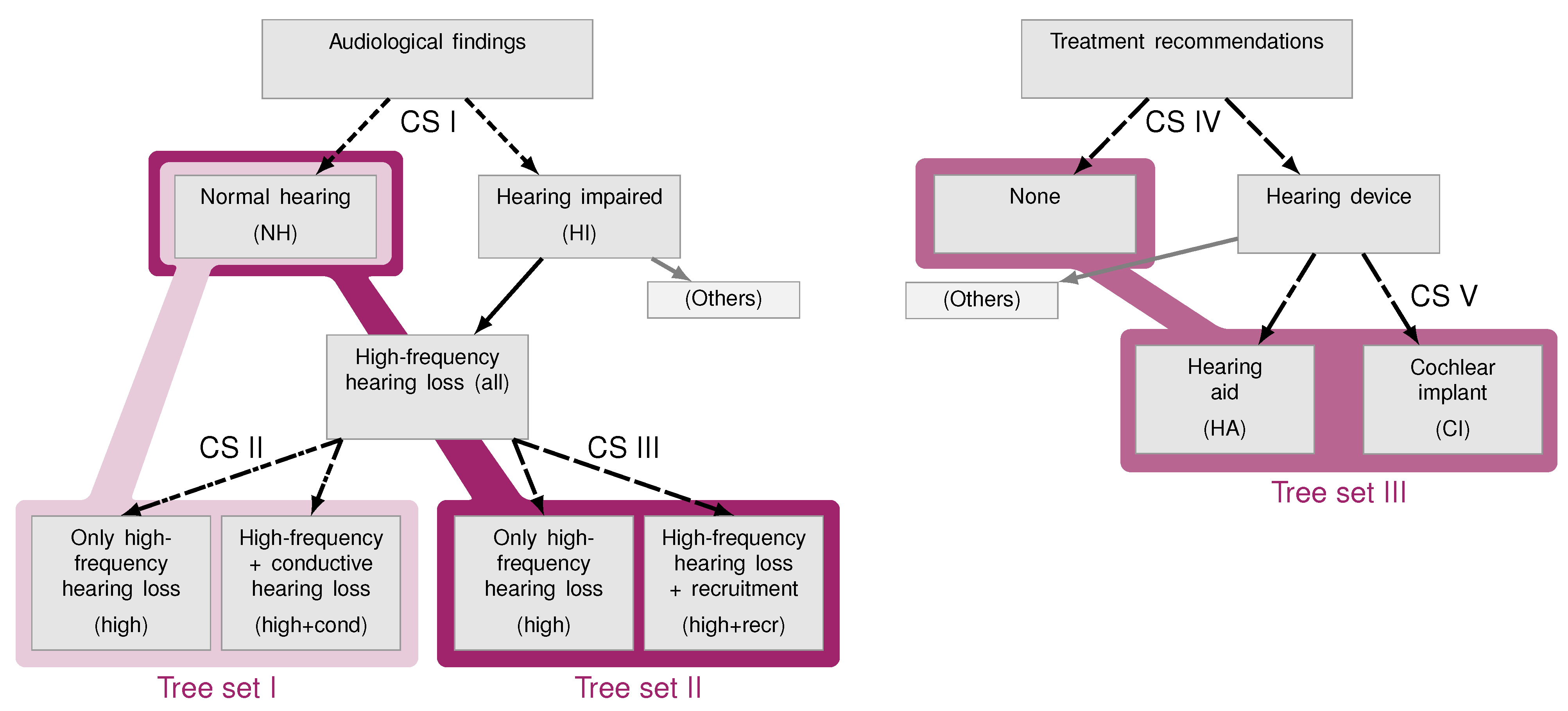

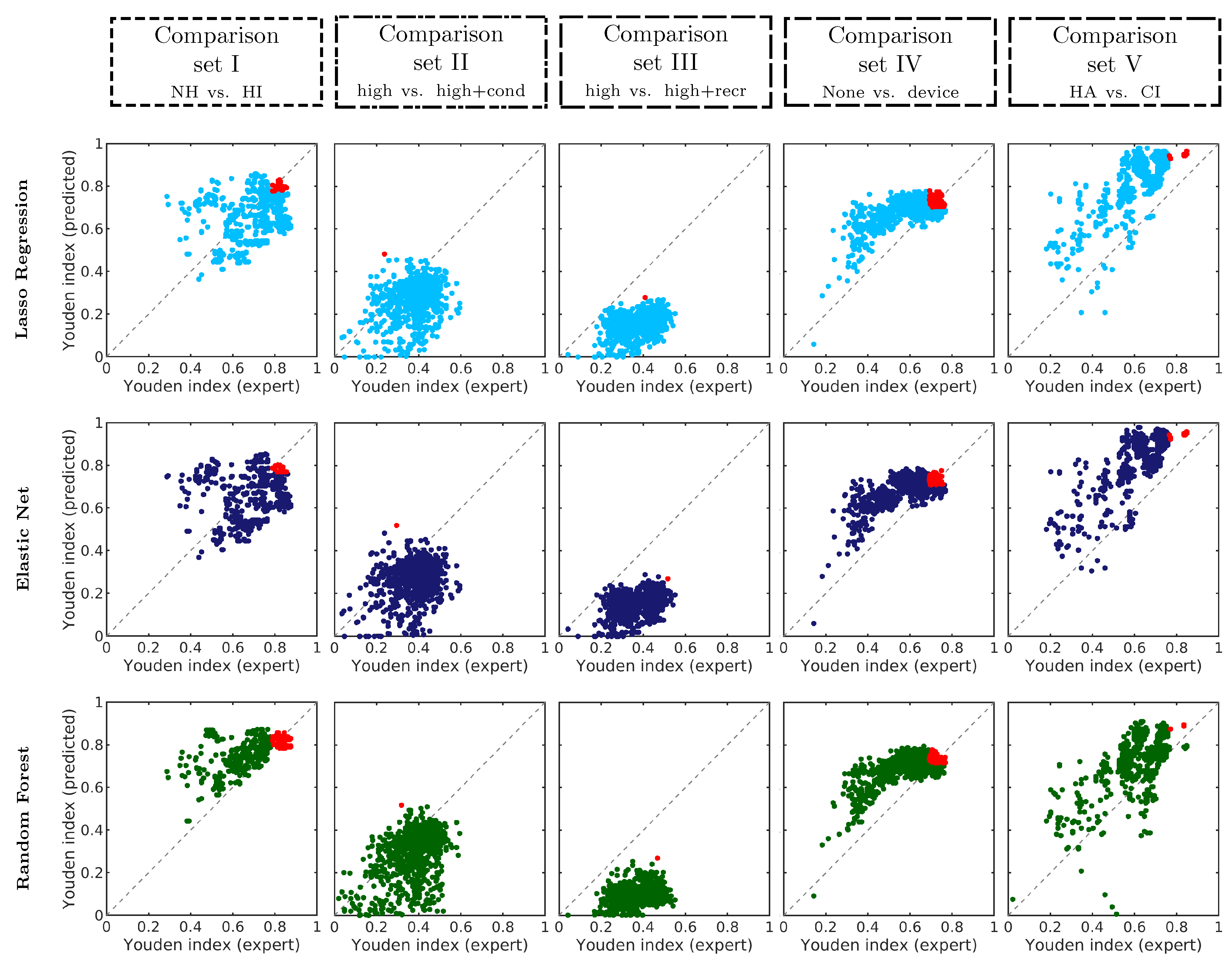


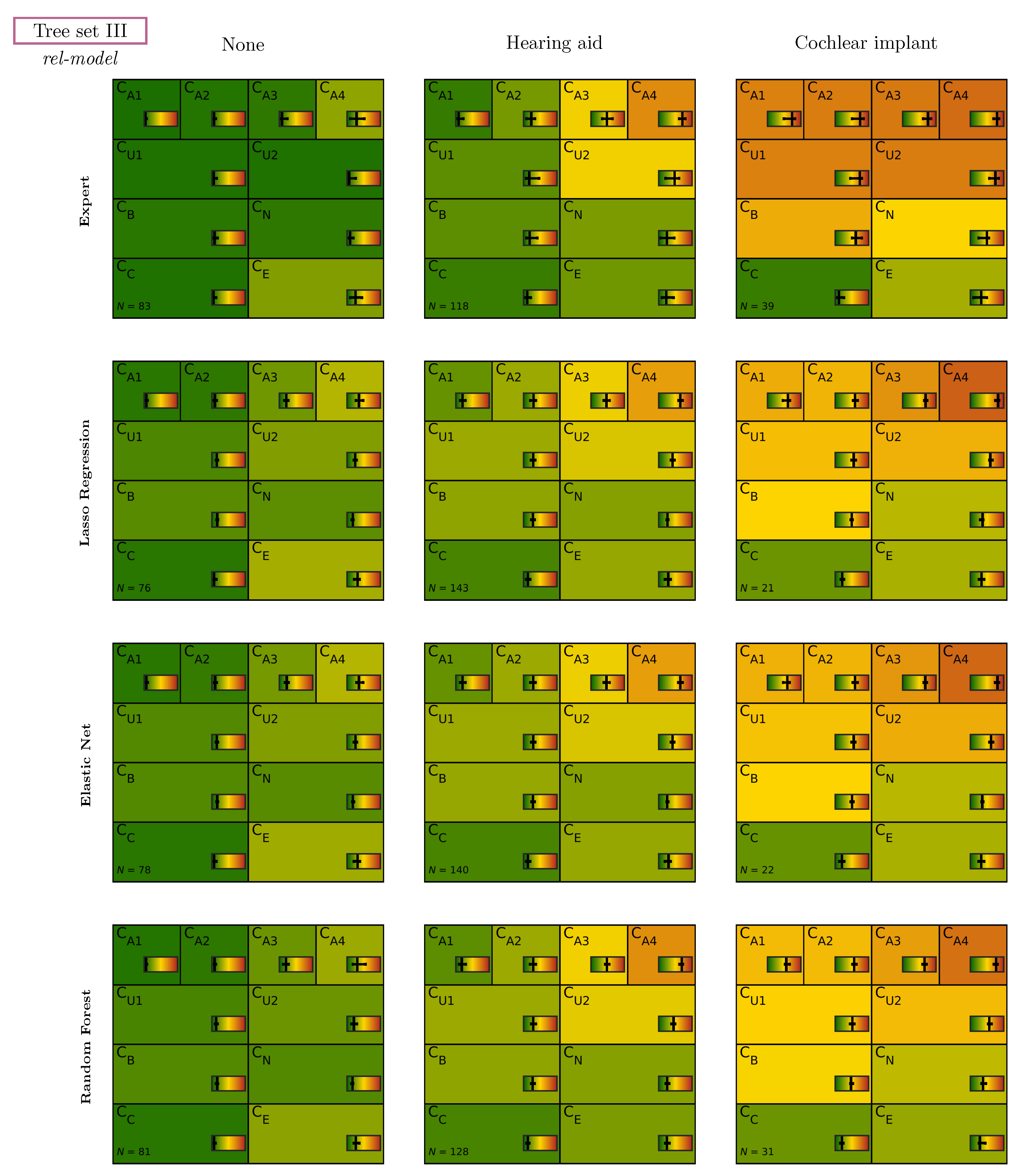
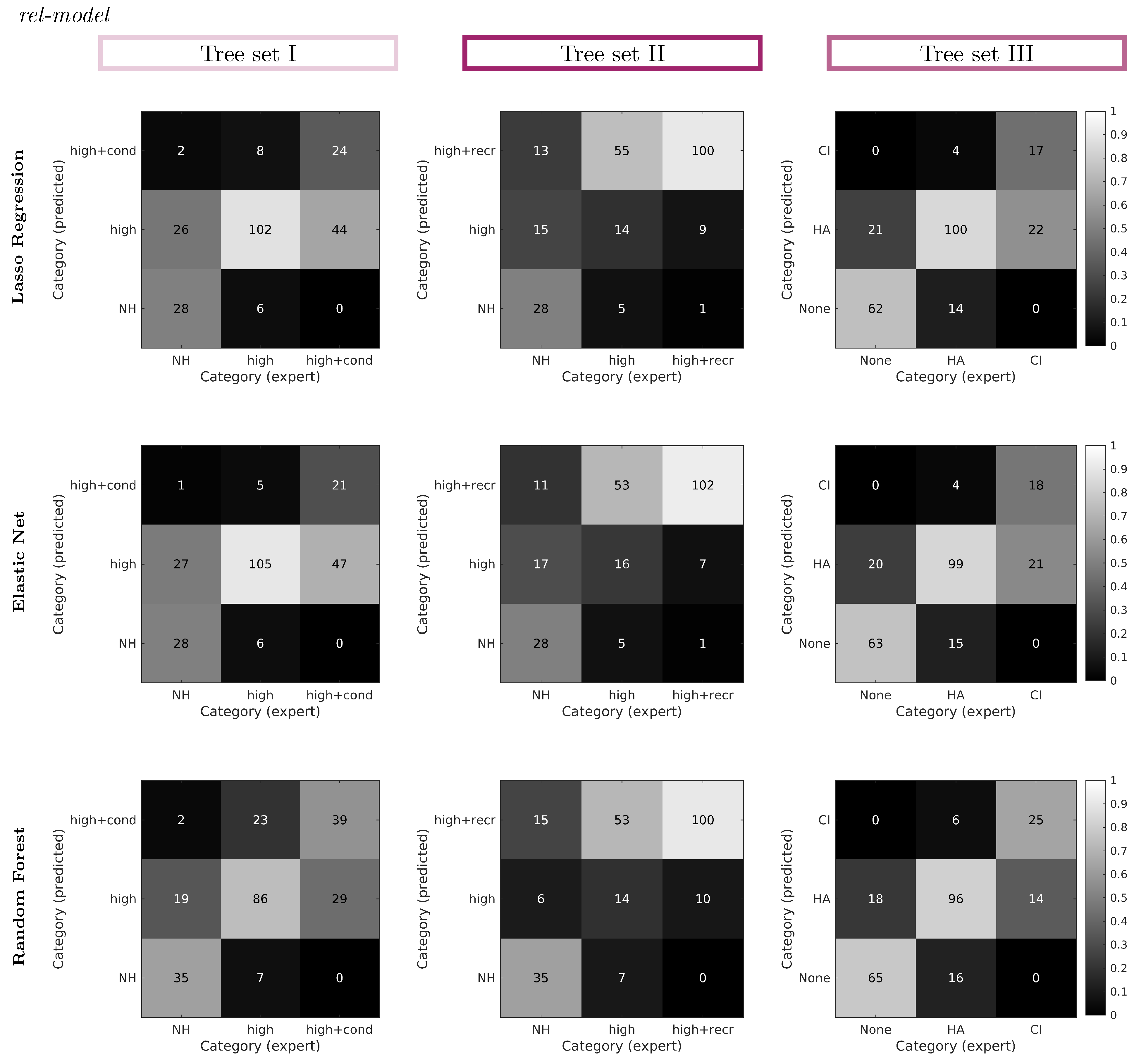
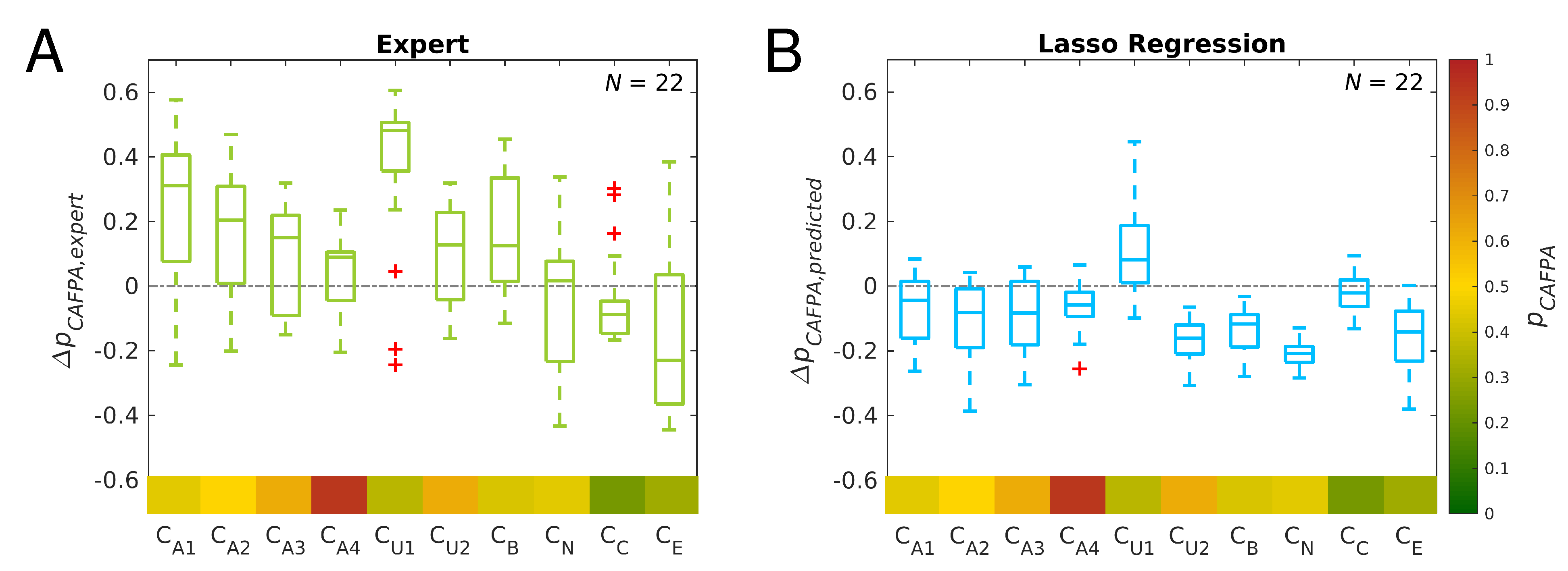

| Weights | Model | Tree Set I | Tree Set II | Tree Set III |
|---|---|---|---|---|
| uniform | Lasso regression | 0.67 | 0.58 | 0.70 |
| uniform | Elastic net | 0.67 | 0.57 | 0.69 |
| uniform | Random forest | 0.66 | 0.60 | 0.71 |
| rel-model | Lasso regression | (0.64) | (0.59) | 0.75 |
| rel-model | Elastic net | (0.64) | 0.61 | 0.75 |
| rel-model | Random forest | (0.67) | (0.62) | 0.78 |
| rel-all | Lasso regression | (0.74) | (0.59) | 0.78 |
| rel-all | Elastic net | (0.73) | (0.58) | 0.77 |
| rel-all | Random forest | (0.71) | (0.58) | 0.78 |
Publisher’s Note: MDPI stays neutral with regard to jurisdictional claims in published maps and institutional affiliations. |
© 2022 by the author. Licensee MDPI, Basel, Switzerland. This article is an open access article distributed under the terms and conditions of the Creative Commons Attribution (CC BY) license (https://creativecommons.org/licenses/by/4.0/).
Share and Cite
Buhl, M. Interpretable Clinical Decision Support System for Audiology Based on Predicted Common Audiological Functional Parameters (CAFPAs). Diagnostics 2022, 12, 463. https://doi.org/10.3390/diagnostics12020463
Buhl M. Interpretable Clinical Decision Support System for Audiology Based on Predicted Common Audiological Functional Parameters (CAFPAs). Diagnostics. 2022; 12(2):463. https://doi.org/10.3390/diagnostics12020463
Chicago/Turabian StyleBuhl, Mareike. 2022. "Interpretable Clinical Decision Support System for Audiology Based on Predicted Common Audiological Functional Parameters (CAFPAs)" Diagnostics 12, no. 2: 463. https://doi.org/10.3390/diagnostics12020463
APA StyleBuhl, M. (2022). Interpretable Clinical Decision Support System for Audiology Based on Predicted Common Audiological Functional Parameters (CAFPAs). Diagnostics, 12(2), 463. https://doi.org/10.3390/diagnostics12020463






